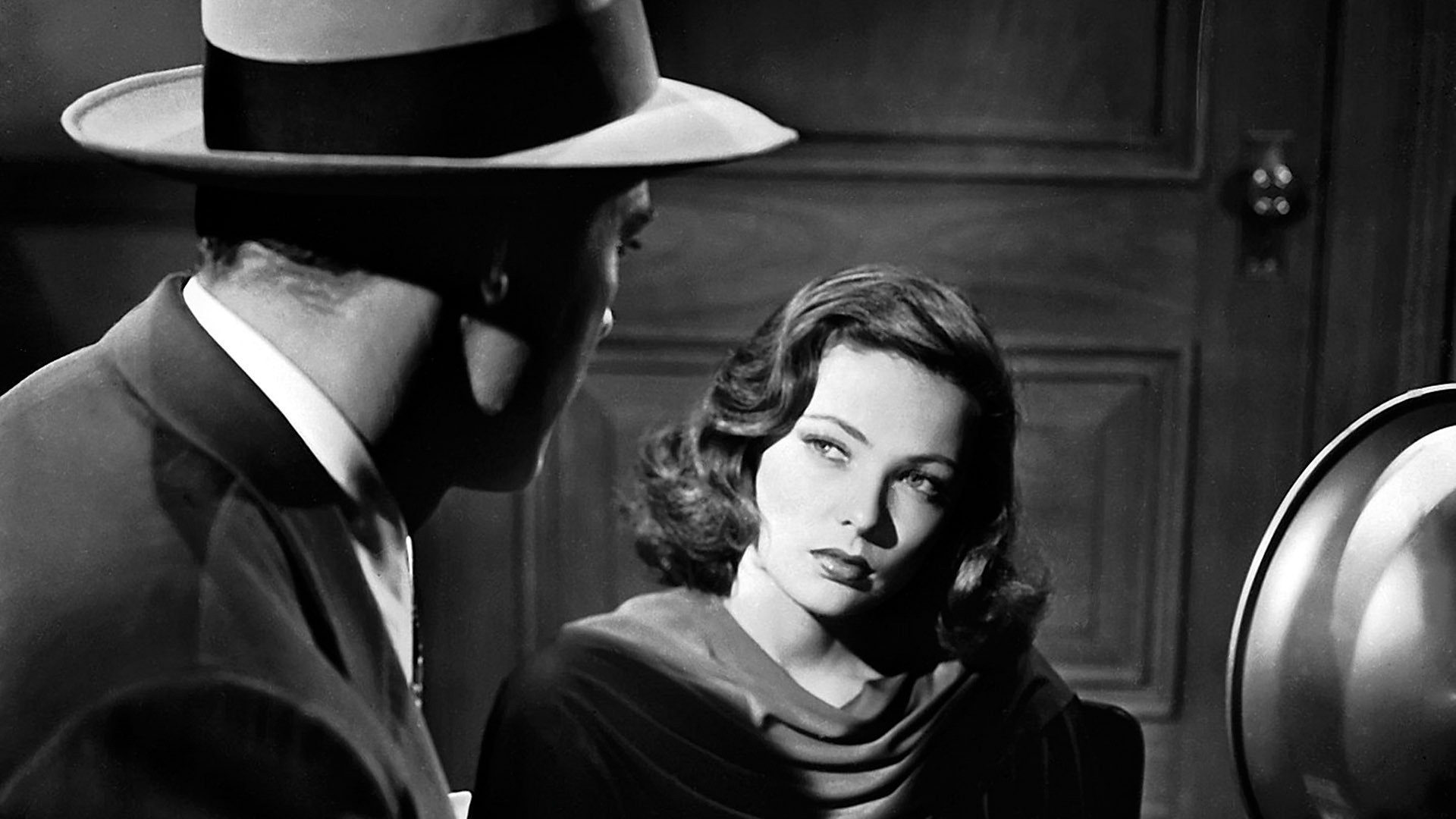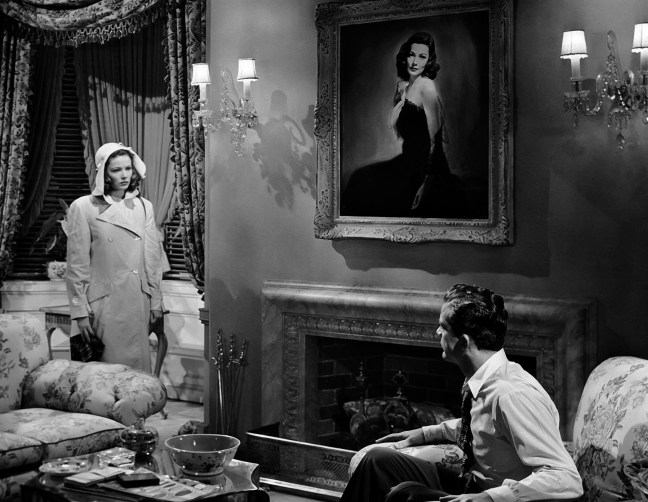
When you study film in a class, you return to iconic scenes to demonstrate terms, themes, and technical knowledge. Turning again and again to iconic reveals, these scenes become teaching moments, divorced from the full context of their containing films. The international archive of YouTube allows for the return to an image or sequence over and over, from device to device. I’ve had friends pull out phones at dinner parties to insist on showing the clip they watch over and over.
One of these great scenes is the revelation of Laura (Gene Tierney) — still alive — to Detective McPherson (Dana Andrews) in Otto Preminger’s Laura. “No salute to Fox is complete without a film clip from it,” Gene Tierney wrote in her autobiography, Self-Portrait. I have been thinking a lot about obsessive desire the last few weeks. Desire requires something not quite there, something out of reach and beyond contentment. Re-watching Laura recently, I realized that I had always remembered this scene incorrectly. In my memory, I had envisioned a cross between the actual event and the entrance of Grace Kelly in Rear Window. I imagined Gene Tierney standing in Kelly’s place, except she remains in black and white. My mistake — a common enough indiscretion — seems fitting. So much of Laura is about the retreading of the past and the shaping of a story.

Much as I love the horror film’s focus on visual scares, especially when events are made so explicit and graphic that they become almost like cartoon violence, the films that always scared me the most were psychological thrillers; films where the aura was what scared me most. Laura is not a horror film, not technically (even if the heroine does rise from the dead). Laura falls into the themes I like to describe as “true horror.” The monsters who manipulate and dominate Laura’s life are too real to me. I know the speed with which people can become infatuated, when small kindnesses are misread as romantic interest and approval of desire. Laura, as a character, is always analyzed, followed, over-heard, and gossiped about as she negotiates her way through a series of difficult men. Above all of these things, Laura is obsessed over in a way that invites the audience to share the obsession, even as they’re terrified of it.
Obsession is a writer’s fundamental subject in many ways. It is certainly part of the process of writing, particularly if the writer finds true magic of the craft in revision. Few films about writers show a writer writing, or at least a writer who has healthy writing habits. Better to be blocked; the frustration helps to build narrative tension in a story. (This also gives the writer of the film an outlet for any issues they might be working through between scripts.) A colleague of mine once likened revision to returning to the scene of a crime, trying to piece together what you forgot the first time. One of the reasons I find Waldo Lydecker (Clifton Webb) so intriguing is that he’s a dedicated writer who is not shown revising. His work creating the history of Laura is relatively unquestioned from the beginning. The story he tells is our only “reliable” source until the subject reappears, alive and well. This appearance throws a wrench in the narrative as effectively as any postmodern device. Our Waldo, our narrator, loses his voiceover around the midpoint of the film, and in so doing, loses control over the events of the narrative.

Waldo imprints himself on everything: in the first scene, his initials appear on each towel in his towel rack, and he maneuvers Dana Andrews to hand him his washrag and robe. Appearing in Laura’s apartment, he tries to remove the pieces of furniture he gave her. He tries to take back what he gave her, as if he was the one who gave her the essence, the style, the sophistication, that made her Laura. These are pieces of her, but they are also pieces of himself given over. The self-consciousness of the writer can sometimes present itself as a lack of consciousness about other people, or a desire to continuously control the narrative. Yet, Waldo’s robe request suggests multiple readings: he’s showing how skinny, older, frailer he looks, how could he commit such a crime? In noir fashion, the lingering hint of Waldo’s feminized fussiness, plus the homoerotic implications of his request, promotes the then common suspicion of homosexual behavior as deviant. Waldo has typed up the interview he gave to the two police officers (did he also do that interview from the tub?), saying “I am the most misquoted man in America.” He controls and sets the record — confirmed by McPherson’s notes — as if to set himself up as the scribe to a coven: the worshipers of Laura.
Thinking about the way in which Laura Hunt was made and shaped, I start to think about the way, in Hollywood lore, actresses are created from chance. Tierney was supposedly discovered on a tour of a film studio, was signed to a contract soon after, and was, in time, a star. She was one of a long line of women whose lives changed and became glorious, fabulous, thanks to chance encounters with the Hollywood production machine. (Clara Bow, Jean Harlow, Lana Turner, or the lesser-known Gail Russell.) In celluloid, as in life, these stars rising from chance encounters and whims often end poorly. In Laura, Tierney found the chance to prove herself and recover from the unfolding personal drama of her domestic life. “The word ‘actress’ has always seemed less a job description to me than a title,” Tierney would write later. “I did not feel I had earned mine yet. Laura was to be my first suspense film. What ever my reservations, I had the title role, a chance to establish myself as a leading lady.”
Tierney’s greatest role is in appearing as a spirit, an essence projected onto a body. It becomes harder and harder for me to describe Laura as an actual person after I watch the film again. She becomes reduced to a series of “types.” What we know of Laura before she became mixed into this world of male gazes comes from the mouths of suspects, often one suspect who knows the power of words placed in the correct order. By turns, he is both the personification of class Waldo sees, as well as the noir “dame” McPherson tries to sweat out under the lights of an interrogation room.
The great sadness of Tierney’s life lurks in the shadow of Laura’s character. Before filming Laura, in the first trimester of her pregnancy, Tierney was kissed by a fan who had developed German measles. Tierney became ill, and her daughter was born with developmental disabilities. During and shortly after the filming of Laura, Tierney would come to realize the extent of her daughter’s disabilities, which would result in her being institutionalized. Writing of her feeling for the character, Tierney describes Laura in terms that I could easily use to describe the actress herself: “She was the victim of events she had not created and could not control. Laura was a woman of mystery and glamour, unattainable, the kind of woman I admired in the pages of Vogue as a young girl.”

Any representations of Laura only go so far when compared to the iconic portrait, given so much screen time, and kept in the background of almost every scene in her apartment by Preminger’s well-placed camera. Biographer Michelle Vogel explains the quality of the portrait of Laura as one of the most mysterious and beautiful portraits in film history:
With this painting being Gene’s representation for a good half-hour of this picture, [Preminger] wanted it to be perfect; it had to have allure and power. The painting was flat and boring. To replace it, Preminger sent Gene to studio photographer, Frank Polony. Several portrait shots were taken, and the best shot was enlarged to the size of a painting. After it was framed it was lightly airbrushed with paint, giving the appearance of brush strokes. The result was a move prop that even today would be up near the price of the ruby slippers from The Wizard of Oz if it were ever to be auctioned.
The painting is, like Laura herself, an illusion, made to look better on film — made to be the object of desire. Within the film, the painting is presented as another representation of Laura that is shaped through the desires of a man obsessed with her (the artist was in love with her when he painted it). The portrait is too perfect, too ideal: a representation guaranteed to result in lustful hopes. It is through this portrait that Detective McPherson falls in love with her. It is through that portrait that she haunts everybody, both her fellow characters and her audience.
Over time, the film has become a subject of obsession itself: “I have had people tell me that they set their clocks to get up after midnight in order to catch Laura on the late, late show,” Tierney remembered with pride. In many ways, Laura can be read as a tale about the dangers of being the golden girl — too beautiful, too popular, too successful. I prefer to look at it as an example of the dangerous way stories can be shaped outside of our control. Laura asks for full engagement from the viewer, to think about the manipulation of scenes, events, and testimony. In the face of desire, Laura asks you to question, even as it draws you in.





1 Comment
Comments are closed.